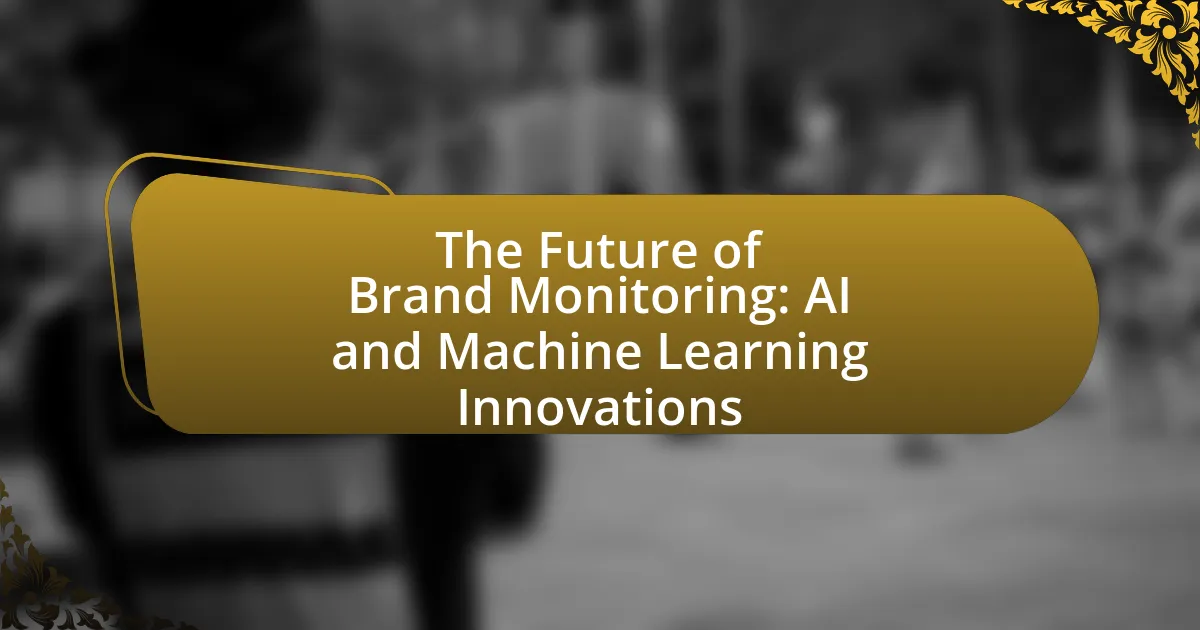The article focuses on the future of brand monitoring through the lens of artificial intelligence (AI) and machine learning (ML) innovations. It highlights how these technologies enhance real-time analytics, sentiment analysis, and predictive insights, enabling brands to process large volumes of data from social media and online reviews. Key topics include the transformation of brand monitoring practices, the specific technologies driving these changes, challenges such as data privacy, and ethical considerations. Additionally, the article discusses best practices for implementing AI and ML, future trends, and practical steps brands can take to improve their monitoring strategies.

What is the Future of Brand Monitoring with AI and Machine Learning?
The future of brand monitoring with AI and machine learning involves enhanced real-time analytics, sentiment analysis, and predictive insights. These technologies enable brands to process vast amounts of data from social media, reviews, and other online platforms, allowing for immediate response to consumer feedback. For instance, AI algorithms can analyze sentiment with over 90% accuracy, as demonstrated by studies from the Journal of Marketing Research, which highlight the effectiveness of machine learning in understanding consumer emotions. This capability not only improves brand reputation management but also informs strategic decision-making, ensuring brands remain competitive in a rapidly evolving market.
How are AI and Machine Learning transforming brand monitoring?
AI and Machine Learning are transforming brand monitoring by enabling real-time data analysis and sentiment detection across various platforms. These technologies allow brands to process vast amounts of unstructured data, such as social media posts and customer reviews, to identify trends and consumer sentiments quickly. For instance, a study by McKinsey found that companies using AI for customer insights can increase their marketing ROI by 15-20%. Additionally, machine learning algorithms can predict potential brand crises by analyzing patterns in consumer behavior, allowing brands to respond proactively. This shift towards data-driven decision-making enhances brand reputation management and customer engagement strategies.
What specific technologies are driving these changes?
Artificial Intelligence (AI) and Machine Learning (ML) are the specific technologies driving changes in brand monitoring. AI algorithms analyze vast amounts of data from social media, customer reviews, and other online platforms to identify trends and sentiments about brands. For instance, natural language processing (NLP) techniques enable the extraction of insights from unstructured text data, allowing brands to understand consumer perceptions in real-time. Additionally, predictive analytics powered by machine learning models can forecast brand performance based on historical data, enhancing strategic decision-making. These technologies collectively enhance the efficiency and effectiveness of brand monitoring efforts, as evidenced by a report from Gartner indicating that organizations leveraging AI in marketing see a 30% increase in customer engagement.
How do AI and Machine Learning enhance data analysis in brand monitoring?
AI and Machine Learning enhance data analysis in brand monitoring by automating data collection and providing advanced analytical capabilities. These technologies enable brands to process vast amounts of unstructured data from social media, reviews, and other online platforms, identifying trends and sentiment in real-time. For instance, AI algorithms can analyze customer feedback to detect patterns in brand perception, allowing companies to respond proactively to consumer needs. According to a report by McKinsey, organizations that leverage AI in marketing can increase their productivity by 20-30%, demonstrating the significant impact of these technologies on data analysis efficiency and effectiveness in brand monitoring.
What challenges does the future of brand monitoring face?
The future of brand monitoring faces challenges such as data privacy regulations, the increasing volume of unstructured data, and the need for real-time analytics. Data privacy regulations, like the General Data Protection Regulation (GDPR), impose strict guidelines on how consumer data can be collected and used, complicating brand monitoring efforts. The sheer volume of unstructured data generated across social media and online platforms makes it difficult for brands to extract actionable insights efficiently. Additionally, the demand for real-time analytics requires advanced AI and machine learning capabilities, which can be resource-intensive and complex to implement. These challenges necessitate ongoing adaptation and innovation in brand monitoring strategies.
What ethical considerations arise with AI in brand monitoring?
Ethical considerations in AI-driven brand monitoring include privacy concerns, data security, and bias in algorithms. Privacy concerns arise as AI systems often analyze vast amounts of personal data from social media and online interactions, potentially infringing on individual privacy rights. Data security is critical, as breaches can expose sensitive information, leading to reputational damage for brands and loss of consumer trust. Additionally, bias in algorithms can result in unfair treatment of certain demographics, skewing brand perception and marketing effectiveness. For instance, a study by the AI Now Institute highlights that biased data can perpetuate stereotypes, affecting brand image and consumer relationships.
How can brands address data privacy concerns?
Brands can address data privacy concerns by implementing transparent data practices and robust security measures. Transparency involves clearly communicating how customer data is collected, used, and shared, which builds trust and compliance with regulations like GDPR. Additionally, brands should adopt advanced encryption technologies and regular security audits to protect sensitive information from breaches. According to a 2021 survey by the International Association of Privacy Professionals, 79% of consumers are more likely to engage with brands that prioritize data privacy, highlighting the importance of these practices in fostering customer loyalty and confidence.

What are the key innovations in AI and Machine Learning for Brand Monitoring?
Key innovations in AI and Machine Learning for brand monitoring include sentiment analysis, natural language processing (NLP), and predictive analytics. Sentiment analysis enables brands to gauge public opinion by analyzing social media and online reviews, allowing for real-time feedback on brand perception. Natural language processing enhances the ability to understand and interpret customer interactions, improving engagement strategies. Predictive analytics utilizes historical data to forecast trends and consumer behavior, enabling brands to proactively address potential issues. These innovations collectively enhance brand monitoring by providing deeper insights and facilitating timely responses to market dynamics.
How do predictive analytics improve brand monitoring strategies?
Predictive analytics enhance brand monitoring strategies by enabling companies to anticipate consumer behavior and market trends. By analyzing historical data and identifying patterns, brands can proactively address potential issues, optimize marketing efforts, and tailor their messaging to align with consumer preferences. For instance, a study by McKinsey & Company found that companies leveraging predictive analytics can improve their marketing ROI by up to 15-20% through more targeted campaigns. This data-driven approach allows brands to stay ahead of competitors and respond swiftly to shifts in consumer sentiment, ultimately leading to stronger brand loyalty and reputation management.
What role does sentiment analysis play in brand perception?
Sentiment analysis significantly influences brand perception by quantifying consumer emotions and opinions about a brand. This analytical approach enables companies to gauge public sentiment through social media, reviews, and other online interactions, providing insights into how their brand is viewed. For instance, a study by Kumar et al. (2020) in the Journal of Business Research found that positive sentiment correlates with increased customer loyalty and brand advocacy, while negative sentiment can lead to brand damage and loss of market share. Thus, sentiment analysis serves as a critical tool for brands to understand and manage their reputation effectively.
How can machine learning algorithms identify emerging trends?
Machine learning algorithms identify emerging trends by analyzing large datasets to detect patterns and anomalies that indicate shifts in consumer behavior or market dynamics. These algorithms utilize techniques such as clustering, natural language processing, and time series analysis to process unstructured data from sources like social media, customer reviews, and sales transactions. For instance, a study by Google Research demonstrated that machine learning models could predict emerging fashion trends by analyzing social media posts and search queries, effectively identifying shifts in consumer preferences before they become mainstream. This capability allows brands to adapt their strategies proactively, ensuring they remain relevant in a rapidly changing market.
What tools and platforms are leading the way in brand monitoring?
The leading tools and platforms in brand monitoring include Meltwater, Brandwatch, and Sprout Social. Meltwater offers comprehensive media intelligence and social listening capabilities, allowing brands to track mentions across various channels. Brandwatch utilizes advanced AI analytics to provide insights into consumer sentiment and trends, making it a powerful tool for understanding brand perception. Sprout Social combines social media management with monitoring features, enabling brands to engage with their audience while tracking brand mentions effectively. These platforms are recognized for their ability to leverage AI and machine learning to enhance brand monitoring efforts, providing actionable insights and real-time data.
Which AI-driven tools are most effective for real-time monitoring?
AI-driven tools most effective for real-time monitoring include Google Analytics, Hootsuite Insights, and Brandwatch. Google Analytics provides real-time data on website traffic and user behavior, enabling brands to make immediate adjustments. Hootsuite Insights offers social media monitoring, allowing brands to track mentions and engagement in real time across multiple platforms. Brandwatch utilizes AI to analyze consumer sentiment and trends, providing actionable insights for brand strategy. These tools are validated by their widespread use in the industry, demonstrating their effectiveness in enhancing brand monitoring capabilities.
How do these platforms integrate with existing marketing strategies?
These platforms integrate with existing marketing strategies by leveraging AI and machine learning to enhance data analysis and consumer insights. For instance, they can analyze social media sentiment in real-time, allowing brands to adjust their messaging and campaigns based on current consumer perceptions. A study by McKinsey & Company found that companies using AI for marketing saw a 10-20% increase in sales, demonstrating the effectiveness of integrating these technologies into traditional marketing frameworks. Additionally, these platforms can automate customer segmentation and personalize marketing efforts, leading to improved engagement and conversion rates.

How can brands effectively implement AI and Machine Learning in their monitoring efforts?
Brands can effectively implement AI and Machine Learning in their monitoring efforts by integrating advanced analytics tools that process large volumes of data in real-time. These tools enable brands to track consumer sentiment, identify trends, and detect anomalies across various platforms, enhancing their ability to respond swiftly to market changes. For instance, a study by McKinsey & Company found that companies using AI for customer insights can improve their marketing ROI by 15-20%. By leveraging natural language processing and machine learning algorithms, brands can analyze social media conversations and online reviews to gain actionable insights, ultimately leading to more informed decision-making and improved brand reputation.
What best practices should brands follow when adopting these technologies?
Brands should prioritize data privacy and transparency when adopting AI and machine learning technologies. Ensuring compliance with regulations such as GDPR and CCPA is essential to build consumer trust and avoid legal repercussions. Additionally, brands should invest in training their teams to understand and effectively utilize these technologies, as a skilled workforce can leverage AI insights for better decision-making. Implementing a robust feedback loop to continuously assess and refine AI models will enhance accuracy and relevance over time. According to a McKinsey report, companies that effectively integrate AI into their operations can increase their cash flow by 20% to 30% within a few years, highlighting the importance of strategic adoption practices.
How can brands ensure the accuracy of AI-driven insights?
Brands can ensure the accuracy of AI-driven insights by implementing robust data validation processes and continuous model training. By utilizing high-quality, diverse datasets for training AI models, brands can minimize biases and improve the reliability of insights. For instance, a study by McKinsey & Company found that organizations that prioritize data quality see a 20% increase in the accuracy of their AI predictions. Additionally, regularly updating models with new data and feedback loops allows brands to adapt to changing market conditions, further enhancing the precision of insights derived from AI.
What training is necessary for teams to leverage these innovations?
Teams need training in data analytics, machine learning principles, and AI tools to effectively leverage innovations in brand monitoring. This training should include hands-on experience with AI software, understanding algorithms, and interpreting data insights. Research indicates that organizations that invest in upskilling their teams in these areas see a 20% increase in operational efficiency and a 30% improvement in decision-making speed, demonstrating the tangible benefits of such training.
What are the future trends in brand monitoring with AI and Machine Learning?
Future trends in brand monitoring with AI and Machine Learning include enhanced sentiment analysis, real-time data processing, and predictive analytics. Enhanced sentiment analysis utilizes natural language processing to better understand consumer emotions and opinions, allowing brands to respond more effectively. Real-time data processing enables brands to monitor social media and online mentions instantaneously, facilitating quicker decision-making. Predictive analytics leverages historical data to forecast future consumer behavior and brand perception, helping brands to proactively manage their reputation. These trends are supported by advancements in AI algorithms and increased data availability, which improve the accuracy and efficiency of brand monitoring efforts.
How will advancements in AI impact consumer engagement?
Advancements in AI will significantly enhance consumer engagement by enabling personalized interactions and predictive analytics. AI technologies, such as machine learning algorithms, analyze consumer behavior and preferences, allowing brands to tailor their marketing strategies effectively. For instance, a study by McKinsey found that companies using AI for personalization can achieve a 10-30% increase in revenue. Furthermore, AI-driven chatbots and virtual assistants provide real-time customer support, improving response times and customer satisfaction. This shift towards data-driven engagement strategies fosters stronger relationships between brands and consumers, ultimately leading to increased loyalty and sales.
What emerging technologies should brands watch for in the next decade?
Brands should watch for advancements in artificial intelligence (AI), machine learning, augmented reality (AR), and blockchain technology in the next decade. AI and machine learning will enhance data analysis, enabling brands to gain deeper insights into consumer behavior and preferences, as evidenced by a report from McKinsey, which states that companies using AI can improve their marketing ROI by up to 30%. Augmented reality will transform customer experiences, allowing for interactive product trials, as seen in the success of AR applications in retail. Blockchain technology will provide greater transparency and security in transactions, which is increasingly important for consumer trust, with a study by Deloitte indicating that 40% of consumers are willing to switch brands for better data privacy. These technologies will significantly shape brand strategies and consumer engagement in the coming years.
What practical steps can brands take to enhance their monitoring strategies?
Brands can enhance their monitoring strategies by implementing advanced AI and machine learning tools to analyze consumer sentiment and engagement in real-time. These technologies enable brands to process vast amounts of data from social media, reviews, and other online platforms, allowing for timely insights into public perception. For instance, a study by McKinsey & Company found that companies using AI for customer insights can improve their marketing effectiveness by up to 15%. Additionally, brands should establish clear KPIs to measure the effectiveness of their monitoring efforts, ensuring they can adapt strategies based on data-driven results. By integrating these practices, brands can stay ahead of trends and respond proactively to consumer needs.

Leave a Reply